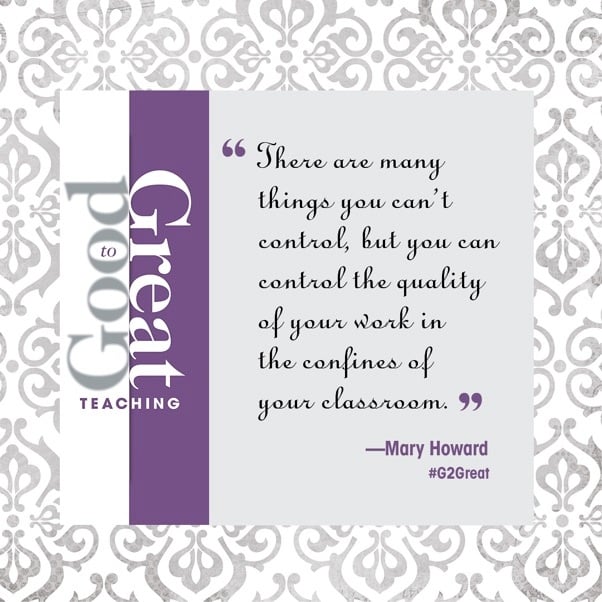
With each tick of the instructional clock, we can lift students to great heights of learning or hold them cognitive hostages in an instructional dead end. Great work doesn’t happen by chance. It’s a conscious choice we make using a new mind-set that forever alters our thinking. -- From Good to Great Teaching: Focusing on the Literacy Work That Matters, pg. 96
In August 2012, Good to Great Teaching: Focusing on the Literacy Work That Matters was published (Heinemann). As my fifth anniversary approaches, I am reminded of the impact this experience had on me personally and professionally. Bringing Good to Great Teaching to life in the company of dedicated educators launched a collaborative exploratory journey that still lingers five years later.
For one school year, I observed, supported and coached teachers in three states through shared dialogue that would gently nudge us all to new thinking. Together we pondered how to notice and alleviate “bad work” that was usurping valuable minutes and explored how to use our newfound time to fuel the “great work” that would elevate instruction and thus enrich the learning lives of children.
And so in honor of the fifth anniversary of Good to Great Teaching, I look back on Ten lessons I learned from teachers focusing on the literacy work that matters.
Lesson 1: Good to Great Teachers View Time as a Precious Commodity
The foundational lesson is the commitment teachers made to make each minute in the learning day count. Out of respect for the irrefutable fact that time is finite; they made a conscious decision to expend time in the most responsive ways. They became dedicated risk-takers by routinely examining their practices with a laser focus. They willingly acknowledged when bad work and great work collided and bravely tackled this mismatch by opting for what was most worthy of their students. They understood that closing a door that limits our impact affords the time to open a new door that has the greatest potential to maximize our impact. They viewed time as a precious gift and chose to spend available time wisely.
Lesson 2: Good to Great Teachers Craft Their Own Professional Reality
Challenges will always exist that threaten to thwart our efforts to achieve great work because questionable mandates will inevitably rear their ugly head. The difference however, is how teachers approached these realities. Rather than view them with a stance of compliant disseminator reduced to what is, they opted to re-envision those realities as what could be. The word “BUT” was replaced with What if..; Instead...; Therefore...; Could we...?; We might...; One alternative… They chose to break down reality roadblocks that could blur our view of possible and refocus their energy on bringing possible into sharper focus.
Lesson 3: Good to Great Teachers Craft their Own Professional Journey
Cookie cutter professional learning was replaced by collaborations that would accommodate unique professional needs. Teachers enthusiastically identified their individual goals as we co-designed a personalized pathway to work toward that goal. They welcomed my support but happily maintained professional responsibility for their own change process. They committed to instructional adjustments because they were integral to that process. Ownership became a central feature of our work together and allowed teachers to forge their own destiny in order to achieve the great work they desired.
Lesson 4: Good to Great Teachers Refute the Myth of One-Size-Fits-All
In recent years, instructional boxes have regained a stranglehold in schools across the country. While teachers had to deal with similar demands, they were determined to take their rightful position in the professional drivers seat. The used required programs as resources, approaching them in flexible ways that would break constraints that could have otherwise confined them by putting children above the dictates of publishers. Differentiation was not just a buzzword emblazoned across a teachers’ guide but an instructional mindset nurtured in a culture of differentiation where teachers assume a leading role as thoughtful decision-maker.
Lesson 5: Good to Great Teachers Embrace Reflection as a Change Tool
Teachers viewed introspective reflection as a powerful professional tool designed to enhance their practices. Each learning experience was seen as an opportunity to gaze into a reflective mirror that would turn the image of now inward and offer them a stepping-stone to next. They valued this reflective process and fearlessly spent as much time pondering teaching after the learning experience as they did before it. They welcomed the mess inherent in responsive teaching because they knew that beneath the muck and mire of their missteps were incredible learning opportunities waiting to be discovered.
Lesson 6: Good to Great Teachers are Fueled by Inspired Curiosity
Teachers were inspired by their own curiosity because they were present in the day-to-day learning moments. Lesson plans written by someone who did not know their students became less relevant than the lesson plan waiting to be written as informed by the child in front of them. Their curiosity about children guided their teaching so they refused to allow labels, numbers, letters, scores or spreadsheets dissuade their belief in their students. As expert kidwatchers they noticed and responded to signs along the way as assessment and instruction became inseparably intertwined. And their deep desire to remain on the very cusp of new understandings was a constant flame that inspired renewed curiosity.
Lesson 7: Good to Great Teachers are Devoted to Professional Learning
Teachers took a courageous leap of faith with me because they knew that what they didn’t know yet could pave the way to explore new layers of knowing. They ranged from relatively new to experienced teachers, but they shared a common belief that their commitment to professional learning required them to assume the role of risk-taker. They willingly put their own teaching under a microscope and savored opportunities for a second pair of eyes and thoughtful dialogue that could move them forward. They embraced their commitment to life-long learning and joyfully explored next steps using research as a flexible guide to support their own learning in the trenches where real children reside.
Lesson 8: Good to Great Teachers Embrace an Unwavering Internal Guide
Teachers possessed a professional GPS of WHY where their innermost beliefs about teaching and learning guided their teaching. These beliefs led them to identify the professional non-negotiables that warranted a place of honor in every day. They never allowed other demands to stand in the way, steadfastly refusing to relinquish what they believed mattered as read-aloud, shared reading, flexible small groups, conferring and independent reading were carved into daily stone. Their belief that children deserved these things every day inspired their resolve to hold them near and dear – and so they did.
Lesson 9: Good to Great Teachers View Children as a Beacon of Hope
Teachers saw their students through a lens of potential and so helping children meet and exceed that potential became a professional battle cry. They maintained ownership of students by refusing to relegate responsibility to others and often chose to keep children in their classrooms even when outside support was offered. They were committed to student learning and so our work together became paramount to that end. They saw their professional success reflected in the eyes of students and were determined to bring that image to life in whatever way necessary no matter how uncomfortable this process became.
Lesson 10: Good to Great Teachers Allow their Heart to Lead the Way
My final lesson is the intricate thread that weaves all other lessons together. Without exception, teachers taught with an open heart where joyful literacy with children at the center became the driving force of all they did. They viewed books as the heart and soul of great work and tirelessly designed an environment that would beckon readers and writers with ample opportunities for children to read, write and talk their way across the day. They knew that teaching children to read and write pales in comparison to helping them become readers and writers both within and beyond our walls. And at the end of our learning year together, it was clear to me that when we teach with an open heart – great work is sure to follow.
Writing Good to Great Teaching five years ago was only the beginning because this book continues to inspire and inform my work. On January 7, 2015, my book took new form in #G2Great, a weekly Twitter chat I co-moderate with educators Amy Brennan and Jenn Hayhurst. #G2Great is a virtual celebration of educators who believe in their responsibility to provide the great work our students deserve. And so the collaborative exploratory journey that began five years ago in Good to Great Teaching continues to shine ever brighter.
Reflecting back on these ten lessons dedicated teachers taught me about great work over the course of a year has inspired me anew. As I continue this work, I am once again reminded that the spirit of Good to Great Teaching rises from the amazing educators who are courageously maintaining their decision-making role by putting their students first day after day. Because in the end, it is teachers who say “No” to the literacy work that doesn’t matter so that they can say “Yes” to the literacy work that does…
And that, my friends, is a choice!


Mary Howard is the author of the Heinemann titles Good to Great Teaching, RTI from All Sides and Moving Forward with RTI. A “teacher’s teacher,” she's been an educator for almost four decades. Mary combines extensive experiences as a special education, Title I, and Reading Recovery teacher with continued in-school support as a reading consultant and literacy coach. She understands the realities of today's classroom and supports teachers across the country in creating high-quality literacy experiences for every child. Mary cohosts a weekly Twitter Chat, #G2Great. You can Follow her on Twitter @DrMaryHoward


